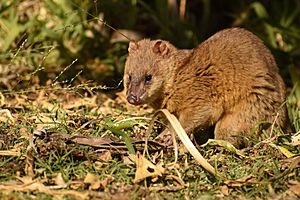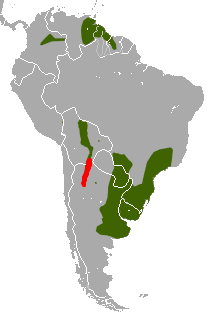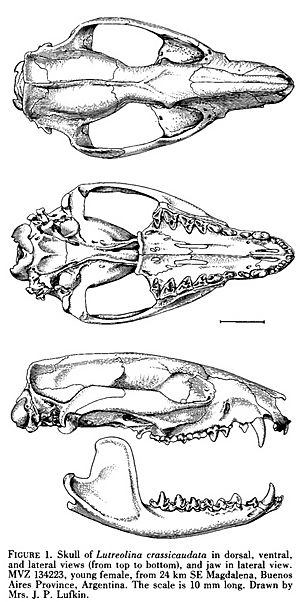Big lutrine opossum facts for kids
Quick facts for kids Big lutrine opossum |
|
|---|---|
 |
|
| Conservation status | |
| Scientific classification | |
| Genus: |
Lutreolina
|
| Species: |
crassicaudata
|
| Subspecies | |
|
L. crassicaudata crassicaudata |
|
 |
|
| Big lutrine opossum range (green) | |
The big lutrine opossum (scientific name: Lutreolina crassicaudata) is a cool mammal from South America. People also call it the little water opossum or thick-tailed opossum. It looks a bit like an otter and has a long tail.
These opossums live in grassy areas, usually close to water. They are most active at night, or during dawn and dusk. They enjoy eating small animals like mice, insects, and crabs. Just like other opossums, the big lutrine opossum is a marsupial. This means the mother carries her babies in a special pouch.
Contents
What is a Big Lutrine Opossum?
The name "lutrine" means "otter-like," and "crassicaudata" means "thick tail." This describes the big lutrine opossum very well! It has a long body, like a weasel, with short legs and small, round ears. Its fur is thick and can be reddish or yellowish.
These opossums are active when the sun is not fully out. They live in grasslands and savannas, always near water. They spend most of their time on land. However, they are also amazing swimmers and climbers.
Where Do They Live?
You can find the big lutrine opossum in several countries in South America. These include Brazil, Argentina, Bolivia, Uruguay, Paraguay, Colombia, and Guyana. The groups in Colombia and Guyana live separately from the others.
They prefer to live in grasslands, savannas, and forests near permanent water. They especially like marshy areas or places along riverbanks.
How Do They Live?
Big lutrine opossums are clever builders. They make cozy nests from grass and reeds. Sometimes, they use old burrows that armadillos or viscachas have left behind.
What Do They Eat?
The big lutrine opossum is a meat-eater and insect-eater. Its skull is built for this kind of diet. They hunt small rodents, birds, insects, and tiny crabs. They are known as the most meat-eating of all opossums. They even prey on venomous snakes!
Opossums in zoos have been seen eating fish, frogs, earthworms, shrimp, and mice. If they live near cities, they might look for food in garbage. But this usually happens only when there isn't enough natural prey around.
How Do They Have Babies?
Big lutrine opossums start having babies in September and continue until April. Then, they take a break for about five months. They have two breeding periods each year. Each time, a mother can have 7 to 11 babies!
Like most marsupials, the tiny babies are born and then crawl into their mother's pouch. They stay there and drink milk until they are big enough to leave. Pregnancy lasts about two weeks. The young opossums stop drinking milk at around three months old.
The first group of babies is born in September. The second group arrives in December or January. These young opossums can have their own babies when they are six months old. However, they usually wait until the next year to start reproducing. Male opossums are heavier than females. This might be because males compete to find a partner.
How Do They Move?
The big lutrine opossum walks on all four legs. It is very quick and graceful. It mostly stays on the ground. But it is also a skilled climber and swimmer. Its long body and short legs help it move through different places.
Even though it's not a "specialized" water animal, it swims very well. It uses its back legs for power and its front legs to paddle. It can run, walk, climb, and swim through all the grassy and marshy areas where it lives. It can even dive underwater to catch aquatic insects and other prey.
Types of Big Lutrine Opossums
There are a few different types, or subspecies, of the big lutrine opossum:
- Lutreolina crassicaudata crassicaudata
- L. crassicaudata paranalis
- Lutreolina crassicaudata turneri
History of the Big Lutrine Opossum
Scientists have found fossils of the big lutrine opossum in Brazil. These fossils show that the animal appeared a very long time ago, during the late Pleistocene epoch. More fossils found in Bolivia and Argentina also point to this time.
For a short period in Argentina, people hunted these opossums for their fur. They used the fur to make clothes. However, this trend didn't last long. The fur would fade in color over time, so it wasn't very popular.
Scientists used to think that opossums living in a place called the Yungas were the same species. But after studying their genes and bodies, they found out it's a different species! It's called Massoia's lutrine opossum (Lutreolina massoia). As its name suggests, the big lutrine opossum is larger than Massoia's lutrine opossum.
Images for kids
See also
 In Spanish: Comadreja colorada para niños
In Spanish: Comadreja colorada para niños





